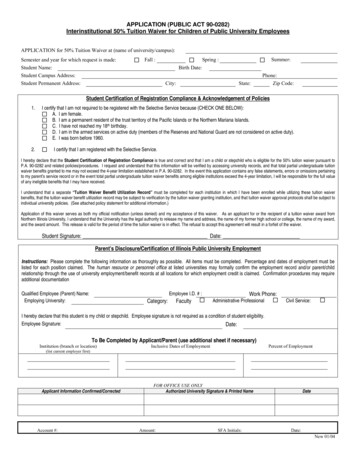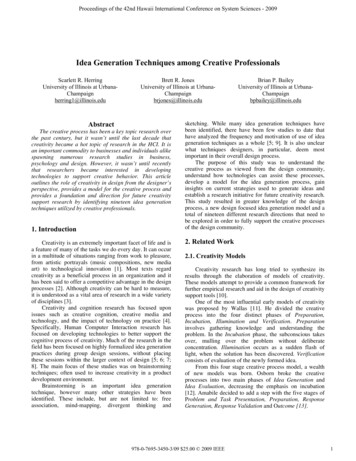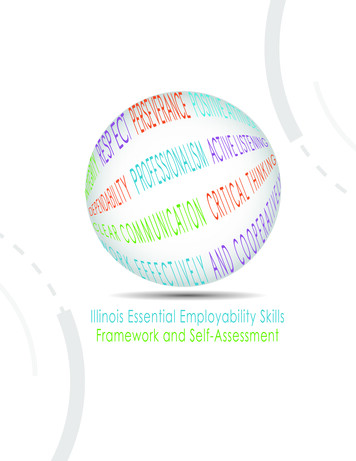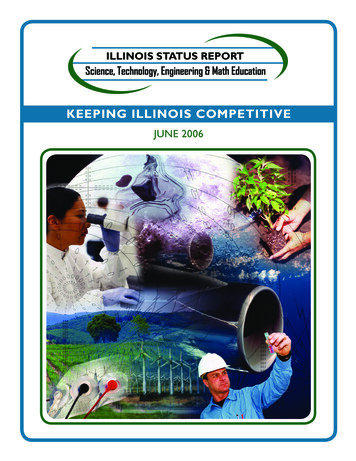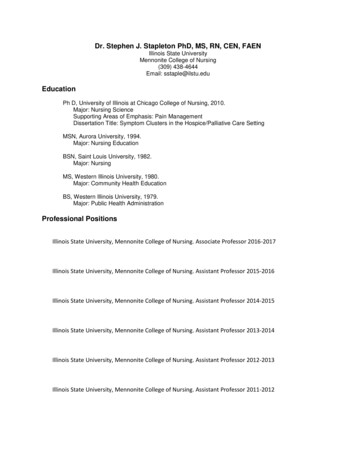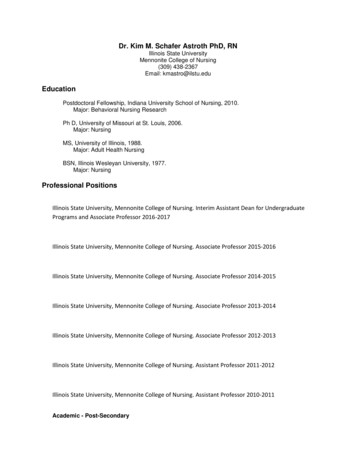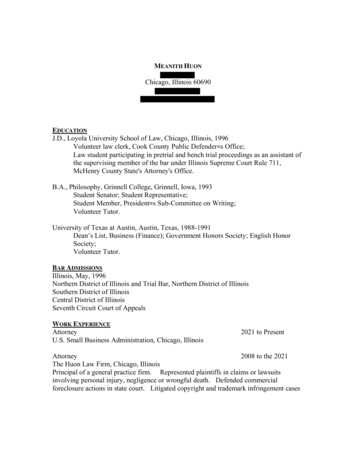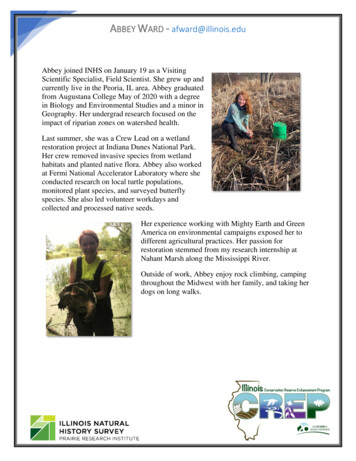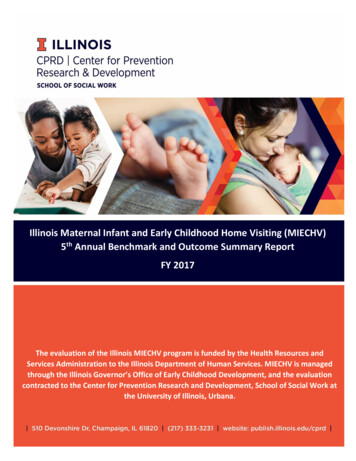
Transcription
Illinois Maternal Infant and Early Childhood Home Visiting (MIECHV)5th Annual Benchmark and Outcome Summary ReportFY 2017FY 2017The evaluation of the Illinois MIECHV program is funded by the Health Resources andServices Administration to the Illinois Department of Human Services. MIECHV is managedthrough the Illinois Governor’s Office of Early Childhood Development, and the evaluationcontracted to the Center for Prevention Research and Development, School of Social Work atthe University of Illinois, Urbana.
Illinois Maternal Infant and Early Childhood Home Visiting (MIECHV)5th Annual Benchmark and Outcome Summary ReportFY 2017Produced for:Illinois Governor’s Office of Early Childhood DevelopmentJames R. Thompson Center160 N. LaSalle St, Suite N-100Chicago, IL 60601igrowillinois.orgReport Prepared by:Center for Prevention Research and DevelopmentSchool of Social WorkUniversity of Illinois510 Devonshire DriveChampaign, IL 61820publish.illinois.edu/cprdNancy Flowers, Director of Research ProgramsScott Hays, Senior Research ScientistStacey McKeever, CQI SpecialistPeter Mulhall, MIECHV Research ConsultantBala Mutyala, Research ScientistBarbara Roth, Data Visualization AnalystMary Anne Wilson, Research Program SpecialistPage 2
Illinois Maternal Infant Early Childhood Home VisitingIllinois Maternal, Infant and Early Childhood Home Visiting (MIECHV) program, situated in theGovernor’s Office of Early Childhood Development (GOECD) completed the fifth full year ofimplementation in late 2017. MIECHV is one of several home visiting (HV) programs in Illinois,and has been federally funded by Health Resources and Services Administration (HRSA),Department of Health and Human Services (HHS) since 2011. This summary document providesan overview of highlights, successes and challenges of the 2016-2017 (October 1, 2016 toSeptember 30, 2017) implementation by providing the key characteristics of the MIECHVcommunities, participants and the impact of the HV services on process and performanceoutcomes. This summary document also describes the influence of Illinois’ two-year budgetstalemate on MIECHV services. The comprehensive results are presented in the MIECHV 5thAnnual Benchmark and Outcome Technical Report.Participants in Illinois MIECHV programsIn 2017, Illinois MIECHV local implementing agencies (LIAs) enrolled over 500 new caregiversand children, continued providing home visiting services for 600 families from the prior fiscalyear, and conducted more than 13,100 home visits. Illinois MIECHV continues to serveparticipants of diverse demographic characteristics across race, ethnicity, and age. The majorityof caregivers were between the ages of 18-24, were not married, and as many as 86% wereunder the 100% Federal Poverty Level (FPL). This profile demonstrates that MIECHV continuesto reach and enroll eligible families in MIECHV’s priority populations that meet one or more ofthe seven eligibility criteria. The most common risk factor was poverty (83%) indicating thatMIECHV is truly reaching Illinois most disadvantaged and needy families. Other risk factorsincluded low student achievement, use of tobacco products, and pregnant and under age 21.Most caregivers report having health insurance as do most children (nearly 100% of children),but coverage is significantly lower for the non-pregnant Hispanic/Latino population with 35%reporting no health insurance coverage.FY 17 Illinois MIECHV data clearly demonstrate that MIECHV programs are positively impactingtargeted benchmarks in the priority populations. However, it is also imperative for the MIECHVprograms to make sure that families not only enroll, but also engage and fully participate inmost or all of model-based activities. For FY 2017, nearly 35% of families completed their modelprograms, 43% were currently receiving home visiting services, while 23% stopped or did notcomplete the full array of services. It should be noted that 23% dropping out of MIECHVprograms is at the lower range for home visiting drop-outs both statewide and nationally.Parents as Teachers (56%) Health Families America (39%) and Early Head Start (5%) reflect thepercent of families enrolled in continuing home visiting programs at the end of the reportingyear.Page 3
Attaining HRSA benchmarks and performance indicatorsIllinois MIECHV, like others states nationwide, was challenged this past year with a majoroverhaul in the number and type of HRSA benchmarks that are divided into six broadcategories: 1) Maternal and newborn health; 2) Child injuries, maltreatment, and emergencydepartment visits; 3) School readiness and achievement; 4) Crime or domestic violence; 5)Family and economic self-sufficiency; and 6) Coordination and referrals.Illinois MIECHV was most successful in attaining benchmark improvements related toscreenings and assessments of caregivers and children. The percentage of families assessed washighest for parent-child interactions (92%), followed by child behavioral concerns (90%),depression screenings (84%), child developmental screenings (81%) and intimate violencescreenings (79%). The next category of performance benchmarks targeted service referrals thatincluded: referrals for tobacco cessation (68%), completed child development referrals (82%),completed depression referrals (53%) and intimate partner violence referrals (40%). Actualchanges or impacts related to outcomes included breastfeeding (32%), which reflects acontinuing improvement over past years, post-partum care (66%), well-child visits (53%), safesleep practices (50%) and continuity of health care coverage (81%). Lastly, pre-term births werereported by 14% of the caregivers in FY 2017, and 1% of families reported child injuriesresulting in a visit to the Emergency Department (ED). A summary table for benchmarks isprovided in Figure 1 below.Page 4
FIGURE 1: BENCHMARK ATTAINMENT BY MIECHV CONSTRUCTProgram and performance gains using Continuous Quality ImprovementIllinois MIECHV’s three program models (Early Head Start, Healthy Families Illinois, and Parentsas Teachers) are evidenced-based, and validated through rigorous experimental testing andprogram evaluations in various community settings. To that end, the evidence of effectivenessfor these programs is well documented; however, the implementation of these programs innew communities and settings requires an ongoing and continuous learning process designedto help these models adapt to the setting, culture, participants and workforce unique to thatsetting. MIECHV CQI provides the knowledge, skills and support to assist HV programs,regardless of the model, to assess, monitor and make mid-course corrections to ensure thatPage 5
process and outcomes are attained. Based on prior year’s data, the FY 2017 MIECHV’s CQIspecialist worked with LIA’s on 14 CQI plans that included language and literacy (5 agencies),access to dental homes (4 agencies), attaining required well child visits (2 agencies), improvingsafe sleep practices (2 agencies) and reducing homelessness (1 agency). Eleven of the LIA’s metor exceeded their goals and 3 agencies made improvements, but did not attain their goals. Anexample of CQI plans and progress is provided for the language and literacy benchmark in Table1 below.TABLE 1. 2017 LITERACY CQI PLANS –SMART AIMS AND RESULTSSMART AimIncrease the % of families who practice literacy daily from13% to 30%Increase the % of families who practice literacy daily from59% to 65%Increase the % of families who practice literacy daily from57% to 70%Increase the average # of days/week that families practiceliteracy from 3.12 to 4.67Increase the % of families practicing literacy 3 times/week from 36% to 85%Increase the % of families who read to children 4 times/week from 75% to 95%ResultImproved?Metgoal?64% 61% 71% Discontinued project due to externalfactors44% 95% Coordinated Intake (CI) finds and enrolls families to MIECHV programsA component of MIECHV that frequently receives less attention and is often under-recognizedfor supporting HV services are the contributions of Coordinated Intake (CI) staff. CI staff arecharged with finding, enrolling and supporting MIECHV families into Illinois’ three modelprograms and other needed services. MIECHV supports full-time CI staff in each communitywho are required to enroll participants not only into MIECHV funded programs but also intonon-MIECHV state funded programs. Each CI staff works in a community with a uniqueconfiguration of populations and health and human service providers. In other words, noevidence-based models exist for CI, but the work requires an array of best practices thatidentify, engage, screen and enroll HV participants into MIECHV and non-MIECHV programs. Itshould also be noted that CI’s often feel pressure to recruit and refer adequate numbers ofparticipants into MIECHV programs to maintain HRSA’s requirement to have at least 85% of HVcaseload slots full at all times. To some degree, FY 2017 was a reboot for Illinois CI staff andactivities. Illinois MIECHV had eliminated the Community Systems Development (CSD) positionand integrated the CSD role into the CI role. This combined role varies by community dependingupon whether an early childhood or HV network and/or collaborative exists in that community.Page 6
CI staff must possess an array of programmatic and community systems knowledge and skills tonavigate diverse communities in Illinois, understand how HV programs work, and connect andnetwork with other community-based organizations to ensure proper linkages and referrals. Itshould be noted that no legislative or administrative mandates exist that require communityorganizations to work together. Some groups work better together than others.The MIECHV’s state team focused efforts to re-engage the CI role by allocating direct staffsupport to CIs, supporting training and technical assistance, conducting monthly conferencecalls, convening quarterly face-to-face Learning Community meetings, developing andexecuting CQI plans. The University of Illinois research and evaluation team conducted a focusgroup of CIs to gain insight to the CI role, assessed experiences and lessons learned, identifiedcommon challenges and explored ways to improve CI effectiveness. Lastly, the state MIECHVteam developed a Coordinated Intake Road Map document comprised of best practices andprocesses to support the CI work.Using information and data for macro-systems and infrastructuredevelopmentThe evaluation team from the University of Illinois has also incorporated several evaluation andanalytical tools to provide additional information and insight to developing and improvingIllinois MIECHV at a systems level. This includes conducting the annual HV/CQI staff survey,comparative salary analysis, staff turnover analysis and exploring special topics such as HVsafety. Each component of this systems’ analysis provides additional insights and informationregarding the status and progress of Illinois MIECHV relative to workforce capacity anddevelopment.Home Visitor and Continuous Quality Improvement Survey (HV/CQISurvey)The Annual HV/CQI survey was designed to assess HVs training and technical assistance needs,CQI practices, job satisfaction, salaries and other topical home visiting issues. The FY 2017survey respondents continue to report that MIECHV’s CQI work is an integral part of their homevisiting services, with strong support from their supervisors and staff, and essential to HVeffectiveness. That is, home visitors report that they see evidence of CQI improving their HVwork and outcomes. The HV/CQI survey also contains questions regarding their sense of safety,and reports of dangerous incidents such as feeling intimidated at a participant home, hearinggunshots, and witnessing or experiencing violence. The frequency of these self-report incidentshas remained essentially the same between 2015 and 2017. One significant safetyimprovement reported by survey respondents between the 2015 and 2017 survey shows thatmore LIA’s are now providing cell phones to home visitors as part of their safety awareness,concerns and policy (46.7% to 62.4%).Page 7
MIECHV home visitors salary assessmentAnother important workforce development factor that MIECHV has been monitoring over thepast 4 years is HV staff salaries. In general, LIAs determine HV salaries based on theirgeographical location (Chicagoland vs. downstate), candidate pool, levels of education,experience, agency pay scales and competitive and comparative advantage. The state of Illinoishas sought to provide guidance to LIAs for minimum salaries for HVs, but these decisions areultimately made by LIAs. Figure 2 shows the data on HV salaries over the past 4 years with themaximum and minimum ranges and the median average. For 2017, the median salary averageactually went down from 31,250 to 30,000 a 4% decrease. This decrease is likely attributableto expansion of MIECHV programs into new Illinois communities in which HVs were hired atentry-level salaries. Regardless, the low range salaries and average salaries remain lamentablylow, which of course, impacts many of the workforce issues discussed in this report.FIGURE 2: HOME VISITING SALARIES 2014-2017MIECHV staff turnoverResearch and practice have repeatedly demonstrated that when a home visitor departs aprogram, for whatever reason, the worse case senario is that participants drop out becausethey do not want to “start over” with another HV. In addition, finding and replacing a highquality HV is challenging and requires signficant time and resources to get a replacement fullyoperational. Although staff turnover is never going to be zero, it often serves as a key indicatorof staff satisfiction, salary, mobility, quality and organziational support for HV work. TheMIECHV evaluation team has been tracking and analyzing staff turnover for several years, andoverall, the HV turnover numbers are not improving. Table 2 below shows the turnovernumbers and percents for FY 2017 by the various MIECHV positions. The HV position that mostdirectly interacts with participants and has the greatest potential to negatively impact familiesPage 8
showed a 31% turnover in 2016, and 38% in 2017. Moreover, the time required to replace a HVposition is about 3 months and the average length of employment 2 years. Hypothetically,these data suggest that almost all HV staff would turn over approximatley every 3-4 years. Itshould be noted that these turnover rates are in line with other national and regional reports,but serve as an important metric for HV services that should be tracked, monitored andanalyzed as part of a system-wide quality improvement process.TABLE 2: MIECHV STAFF TURNOVER, SFY 2016 AND SFY 2017MIECHV PositionsContractedStaff HiresSFY16 SFY17SFY16 SFY17Staff Exits(Turnovers)SFY16 SFY17% TurnoversAverageLength ofVacancy(months)SFY16 SFY17SFY16 SFY17AverageLength ofEmployment(years)SFY16 S FY17Coordinated Intake (CI)59061420%44%5.64.81.92.3CI .21.41.92.2Doula Home Visitor44353275%50%0.40.51.82.2Home Visitor (HV)39471324121831%38%3.63.01.82.2Other Staff151919177%37%2.31.83.23.7HV/Doula 22%36%2.62.42.22.6DoulaGrand TotalState fiscal and political factors impacting MIECHV programsIllinois’ well known budgetary stalemate began in 2015 and ended in 2017,creating a difficult,and at times debilitating influence on many of Illinois health and human service programs,including home visiting. The signing of a state budget in August 2017 after two years of “nobudget” was a welcome relief to Illinois agencies and organizations. Although MIECHV is afederally funded initiative, MIECHV programs are supported and embedded into a state fundedadminstration and infrastructure and co-exist within non-MIECHV programs. The budget issueresulted in at least one agency closing down, another agency choosing not to accept MIECHVfunds, agency staff furloughed and laid off, and staff vacating state-funded positions for otheremployment. Most agencies did receive some funding during this time period, but the budgetuncertainty was a major motivation for problems with staff turnover increasing, low morale andan uncertain future. Upon the July 2017 budget authorization and approval, the state of Illinoisbegan the process of re-engaging Illinois’ health, human services and community-basedprograms with full funding, including HV programs. Although no one person or entitycompletely understands the full impact of these events, examples of negative consequencesabound.Page 9
Conclusions and recommendations derived from MIECHV 2017 evaluationand performance benchmark reportIllinois MIECHV weathered a challenging and transitional year in 2017. Despite the budgetstalemate and the transition to updated and new benchmarks, Illinois MIECHV was able tocontinue to meet HRSA’s performance benchmark requirements, continue to programmaticallyimprove through CQI, reinvigorate the CI systems, expand the number of communities served,and pilot several innovative programs – universal screening, child welfare integration, and ahome visiting with homeless families demonstration project.A major strength for Illinois MIECHV is the fact that Illinois has a long history and inexorablecommitment to home visiting and early childhood programs and policies. This commitment isbest exemplified by leadership from the GOECD, public-private partnerships such as the EarlyLearning Council and multiple committees that support this work. In addition, the Home VisitingInfrastructure Collaborative (HVIC), a voluntary partnership among Illinois HV provider groupsemerged, and began collaborating and problem solving during these challenging times. HVIChas now developed into a highly respected, authoritative, and representative leadership groupthat will guide Illinois HV into the next generation of state and community programs, policiesand supports. HVIC meets quarterly to address HV issues with a planned agenda that leads andresponds to the challenges of state and community HV systems and programs. Within theIllinois HV context, MIECHV needs to continue to collaborate, develop, improve and refine theircomprehensive and integrated efforts in the following areas:1.Serve as leader and partner in HVIC as it continues to develop and address Illinois HVissues.2.Refine the management information system (MIS) to provide data for coordinatedintake, LIAs, family and state level systems that can be available in real time formonitoring and improving HV services.3.Improve MIS capacity to monitor program model fidelity and implementation and trackthe family and children transitions into other programs and services.4.Continuous quality improvement is the only way to ensure HV programs are succeeding,and improving or identifying problems that surface. Illinois recently shifted CQI to anissue or topic driven CQI process, which seems to be working well. However, individualHV programs may still need targeted attention unique to their staff, program orcommunity.5.Illinois MIECHV piloted several innovative HV programs that include universal intake,child welfare integration and home visiting with homelessness families. Lessons learnedfrom these pilot projects should be summarized and shared with the other HV programsas appropriate.Page 10
6.The CI system was successfully retooled in 2017 but still needs robust leadership, crosscommunity collaboration, expert training and technical assistance, and furtherdevelopment of the CI Learning Community. This is going to be particularly important inthe upcoming years as the Illinois State Board of Education (ISBE) recently began hiringCIs for their HV programs that serve in MIECHV communities as well. Significantopportunities for synergy and innovation are possible.7.Continue to review and assess state systems and infrastructure data to understand andproblem solve issues related to workforce development (e.g., skill sets, salaries,professionalization, organizational effectiveness), training and technical assistanceneeds, innovation and technology solutions, benchmark attainment and populationoutcomes.Page 11
Scott Hays, Senior Research Scientist Stacey McKeever, CQI Specialist Peter Mulhall, MIECHV Research Consultant . This includes conducting the annual HV/CQI staff survey, comparative salary analysis, staff turnover analysis and exploring special topics such as HV safety. Each component of this systems' analysis provides additional insights .
